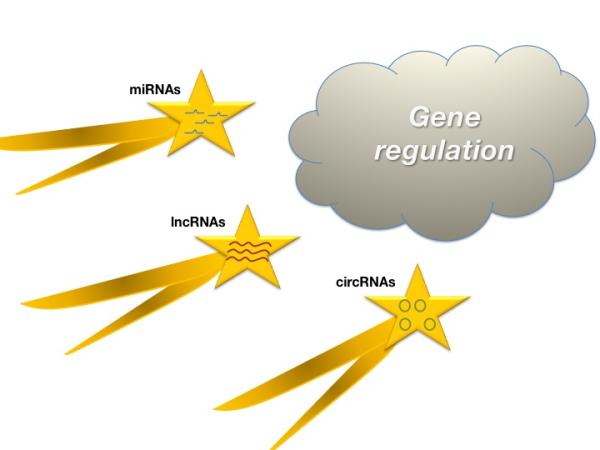Non-Coding RNAs Are Rising Stars in Gene Expression Regulation
During my Ph.D., I decided to pursue my thesis project in a lab working in the RNA field and, more specifically, on the mechanisms of alternative splicing regulation. Moving onto my post-doctoral training, I decided to stay in this field mainly because I found it fascinating to work with RNA. It is such a flexible and diverse molecule, but also largely unexplored. I believed that this relatively new area of research would attract more interest among scientists, and the last few years show that I was thinking in the right direction.
A few decades ago, the central dogma of biology was formed wherein DNA replicates itself and is used as a template for RNA production. RNA is then responsible for delivering the message for protein formation in the cytoplasm. However, this oversimplified model is changing. For example, with the discovery of alternative splicing, we now know that most human genes produce more than one protein isoform, and this is the main reason for protein isoform diversity.
It is now well established that there are several classes of RNA that do not encode for any protein, but do play important roles in the cell. The RNA biology field has turned much of its attention to exciting and promising non-coding RNA research, highlighting RNA’s role in regulating gene expression.

miRNAs, lncRNAs and circRNAs are newfound types of non-coding RNAs that are shedding light on the regulation of gene expression.
MicroRNAs (miRNAs) were the first group of non-coding RNA molecules to be extensively studied regarding gene expression regulation. Since the discovery of the first microRNA two decades ago (Lee RC et al., Cell, 75, 1993), researchers found that miRNAs have the ability to bind to messenger RNAs (mRNAs) and block protein expression, either by promoting degradation or by silencing translation. With interest rising around miRNAs, a lot of answers have been revealed about how they are generated and the mechanisms for how they work (by discovering the RISC complex and the seed sequences on their target mRNAs). Researchers have formed a long and growing list of miRNAs that exist in a cell. Several of them have central roles in important biological processes, such as cancer and aging.
New types of non-coding RNAs with similar abilities to miRNAs have emerged in the last few years. The long non-coding RNAs (lncRNAs), for instance, were recently identified as major regulators of gene expression. At first, only a few lncRNAs were known to exist, but as technologies improved, next generation sequencing (RNA-seq) revealed a large number of lncRNAs, with several of them playing roles in epigenetic regulation and gene expression during embryonic development or cancer.
But even before the scientific community could fully grasp lncRNAs’ functions, a new class of non-coding RNAs surfaced. Circular RNAs (circRNAs) were found to be important in modulating the action of miRNAs, since they can work as sponges to rapidly change miRNAs concentration according to cellular conditions or needs (Hansen et al., and Memczak et al., Nature, 495, 2013).
There are still many unanswered questions and areas to be investigated. For example, a big challenge remains to understand how circRNAs are generated from splicing and why they move into circularity instead of the linear form. We also do not know if circRNAs regulate protein molecules in the same way they regulate miRNAs and, if so, what are the mechanisms of action.
With the new and developing understanding of non-coding RNAs’ roles in gene expression regulation, we can modify the central dogma of biology. Scientists working on projects requiring modulation of specific gene expression can use non-coding RNAs as powerful tools to achieve gene knockdowns. In addition, non-coding RNAs might also be considered as hot candidates for therapeutic approaches. Nevertheless, I am confident that non-coding RNAs will attract much more interest in the near future.
Related Blog Posts
This page was last updated on Wednesday, January 31, 2024
